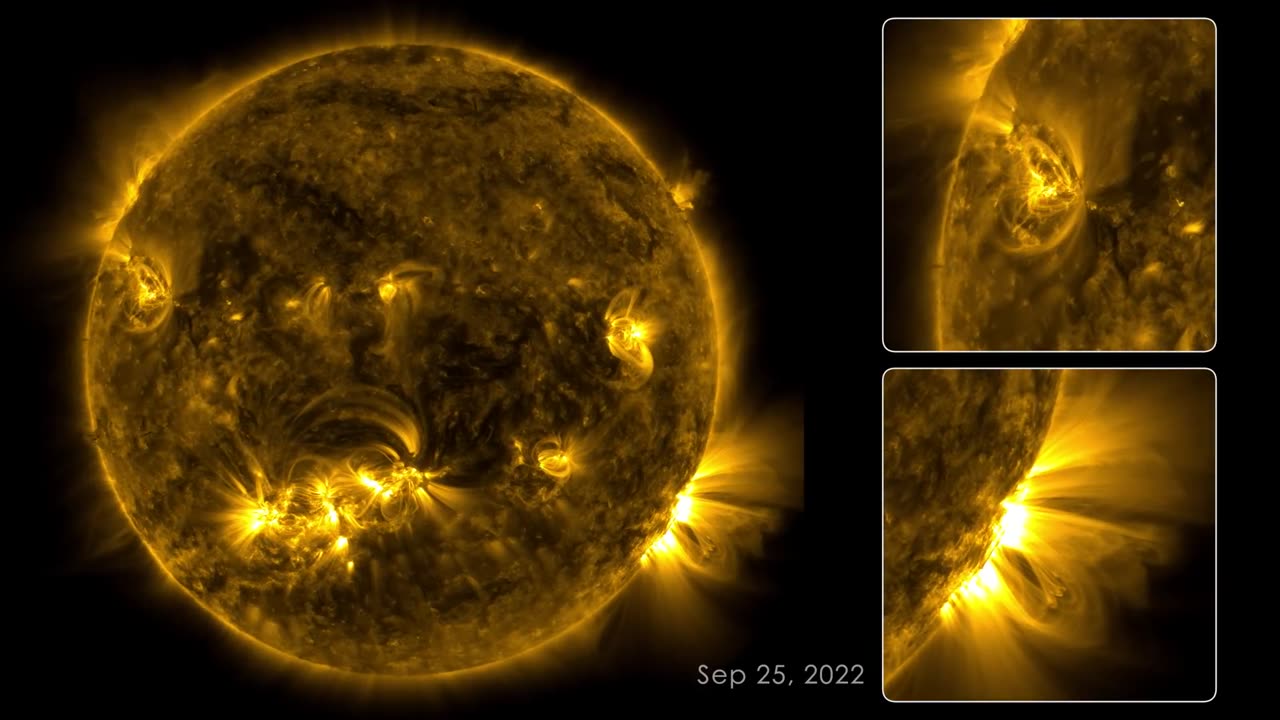Premium Only Content

133 Days on Sun
This video chronicles solar activity from Aug. 12 to Dec.
22, 2022, as captured by NASA's Solar Dynamics
Observatory (SDO). From its orbit in space around Earth,
SDO has steadily imaged the Sun in 4K x 4K resolution for
nearly 13 years. This information has enabled countless
new discoveries about the workings of our closest star
and how it influences the solar system. With a triad of
instruments, SDO captures an image of the Sun every 0.75
seconds. The Atmospheric Imaging Assembly (AIA)
instrument alone captures images every 12 seconds at 10
different wavelengths of light. This 133-day time lapse
showcases photos taken at a wavelength of 17.1
nanometers, which is an extreme-ultraviolet wavelength
that shows the Sun's outermost atmospheric layer: the
corona. Compiling images taken 108 seconds apart, the
movie condenses 133 days, or about four months, of solar
observations into 59 minutes. The video shows bright
active regions passing across the face of the Sun as it
rotates. The Sun rotates approximately once every 27
days. The loops extending above the bright regions are
magnetic fields that have trapped hot, glowing plasma.
These bright regions are also the source of solar flares,
which appear as bright flashes as magnetic fields snap
together in a process called magnetic reconnection. While
SDO has kept an unblinking eye pointed toward the Sun,
there have been a few moments it missed. Some of the
dark frames in the video are caused by Earth or the Moon
eclipsing SDO as they pass between the spacecraft and
the Sun. Other blackouts are caused by instrumentation
being down or data errors. SDO transmits 1.4 terabytes of
data to the ground every day. The images where the Sun is
off-center were observed when SDO was calibrating its
instruments. SDO and other NASA missions will continue
to watch our Sun in the years tocome, providing further
insights about our place in space and information to keep
our astronauts and assets safe. The music is a
continuous mix from Lars Leonhard's "Geometric Shapes"
album, courtesy of the artist. Credit: NASA's Goddard
Space Flight Center Scott Wiessinger (PAO): Lead
Producer Tom Bridgman (SVS): Lead Visualizer Scott
Wiessinger (PAO): Editor This video can be freely shared
and downloaded at https://svs.gsfc.nasa.gov/14263.
While the video in its entirety can be shared without
permission, the music and some individual imagery may
have been obtained through permission and may not be
excised or remixed in other products. Specific details on
such imagery may be found here:
https://svs.gsfc.nasa.gov/14263. For more information on
NASA's media guidelines, visit
https://nasa.gov/multimedia/guidelines. Video
Description: On the left side of the frame is the full circle
of the Sun. It appears in a golden yellow color, but
splotchy and with thin yellow wisps extending from the
surface. Some areas are very bright and others almost
black. The whole Sun rotates steadily, with one full
rotation taking 12 minutes in this time lapse. There are
usually only a few bright regions visible at a time and they
shift and flash like small fires. From these regions there
are wispy loops reaching up above the surface that rapidly
change shape and size. On the right side of the frame are
two white-outlined squares with enlargements of
interesting regions of the Sun. If you liked this video,
subscribe to the NASA Goddard YouTube channel:
/nasagoddard Follow NASA's Goddard Space Flight Center Instagram
http://www.instagram.com/nasagoddard Twitter http://twitter.com/NASAGoddard Twitter http://twitter.com/NASAGoddardPix Facebook: http://www.facebook.com/NASAGoddard Flickr http://www.flickr.com/photos/gsfc
-
 UPCOMING
UPCOMING
LFA TV
11 hours agoBURN, LOOT, MURDER TIME! | LIVE FROM AMERICA 12.10.24 11am EST
2.18K1 -
 LIVE
LIVE
Matt Kohrs
9 hours agoTurnaround Tuesday, Breaking News & Live Trading $1M || The MK Show
1,075 watching -
 42:27
42:27
BonginoReport
4 hours agoWorst Woman in America Considered for "Person of the Year" Award (Ep.101) - 12/10/2024
60.1K129 -
 LIVE
LIVE
Vigilant News Network
17 hours agoUnusual Details Emerge About UnitedHealthcare CEO’s Killer | The Daily Dose
1,388 watching -
 LIVE
LIVE
2 MIKES LIVE
1 hour agoThe Mike Schwartz Show 12-10-2024 with Dr. Michael J Schwartz
321 watching -
 47:53
47:53
PMG
13 hours ago $0.52 earned"Hannah Faulkner and Brett Raio | TAKING BACK MUSIC FOR CHRIST"
20.2K5 -
 14:01
14:01
Melonie Mac
15 hours agoTomb Raider the Angel of Darkness Statue Unboxing!
61.6K17 -
 8:16
8:16
Chrissy Clark
16 hours agoCan A Christian ØF Model Exist?
50.7K58 -
 27:49
27:49
Goose Pimples
1 day ago7 Ghost Videos Scarier Than Googling That Weird Rash
29.5K12 -
 14:30
14:30
Rethinking the Dollar
14 hours agoNY Gets Ready! Stimulus Checks In BUDGET Proposal For 2025
20.9K7